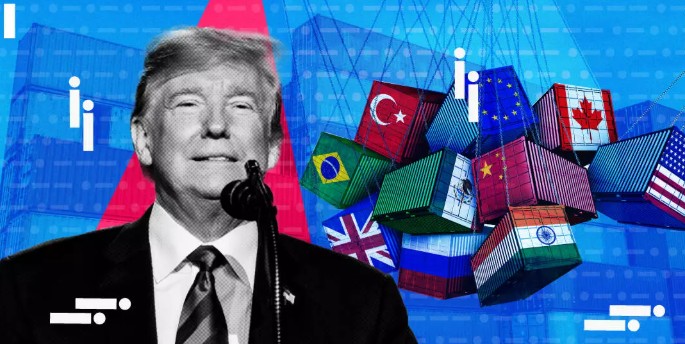48 Hours That Shook Global Trade: The Tariff Avalanche of July 31–August 1, 2025
Summary Introduction: A Global Economic Shockwave
In the span of just two days, the world watched the economic compass spin wildly as former U.S. President Donald Trump executed a sweeping trade overhaul. On July 31 and August 1, 2025, the United States unilaterally imposed new tariffs on over 90 countries, upending global supply chains, igniting diplomatic tensions, and prompting markets to reprice the risks of protectionism. This wasn’t simply about taxation it was about the assertion of American dominance in the global trade theater.
The tariffs were more than symbolic. They impacted billions of dollars in goods ranging from cars to copper, garments to semiconductors and spurred retaliatory actions, investment pledges, and widespread re-evaluations of trade alliances. Some nations scrambled to comply, others pushed back, and a few found unexpected opportunities amid the chaos.
Below is a breakdown of how the shock played out for key countries and what it means moving forward.
Country-by-Country Breakdown: Before & After
🇨🇦 Canada: From Calm Waters to a Trade Storm
- Before: Benefited from USMCA; little friction outside occasional trade spats.
- July 31: Warned of 35% tariffs due to alleged inaction on fentanyl and retaliatory levies.
- August 1: Tariffs enacted; non-compliant goods taxed at 35%, transshipments at 40%.
- Aftermath: PM Carney condemned the move; Ontario proposed retaliatory steel tariffs. Domestic focus on self-reliance intensified.
India: From Defiance to Damage Control
- Before: Maintained high tariffs; strong ties with Russia.
- July 31: Hit with 25% tariff; further penalties hinted.
- August 1: Markets rattled; exports projected to drop from $86.5B to $60.6B.
- Aftermath: Emphasized internal supply chain growth and new regional partnerships.
Brazil: Retaliation in the Crosshairs
- Before: Moderate U.S. trade partner; rising political tension.
- July 31: Slapped with 50% tariff; exceptions for select goods.
- August 1: Impacted steel and soy exports; agricultural sector mobilized.
- Aftermath: Brazil turned to China and demanded federal support.
Mexico: Negotiating Under Fire
- Before: Tightly integrated with U.S. via USMCA; border issues loomed.
- July 31: Received 90-day delay; warnings issued.
- August 1: Non-USMCA goods taxed at 25%; key sectors hit hard.
- Aftermath: Launched “Trade Shield” to expand alliances beyond the U.S.
European Union: Diplomacy Meets Dollars
- Before: A strong trade partner; lingering disagreements.
- July 31: Faced 15% tariffs; investment demands issued.
- August 1: Conceded to $750B in energy deals and $600B in U.S. investments.
- Aftermath: Mixed reactions; some saw stability, others economic coercion.
Japan: Caught in the Crossfire
- Before: Stable relations with mounting pressure for deeper cooperation.
- July 31: Proposed 25% tariff; negotiations escalated.
- August 1: Agreed to $550B U.S. investment; tariff reduced to 15%.
- Aftermath: Semiconductor investments surged; auto sector faced headwinds.
South Korea: Strategic Leverage Pays Off
- Before: Loyal ally with longstanding steel duties.
- July 31: Threatened with broader tariffs; pledged investments and energy deals.
- August 1: Steel duties remain; most other goods taxed at 15%.
- Aftermath: Engaged regional diplomacy with Japan to fortify trade resilience.
Cambodia & Bangladesh: From Danger Zone to Relief
- Before: Braced for tariffs up to 49%; garment industries vulnerable.
- July 31: Revised rates following advocacy efforts.
- August 1:
- Cambodia: Final tariff set at 19%.
- Bangladesh: Final tariff set at 20%.
- Aftermath: Job preservation seen as victory; new trade routes explored.
How Peacock Tariff Consulting Can Help Businesses Navigate the Storm
In an economic landscape transformed overnight, Peacock Tariff Consulting stands at the forefront of helping businesses adapt, protect margins, and seize new opportunities.
What Peacock Offers:
- Tariff Forecasting & Strategy: Predict the next wave of policy changes and plan proactive defenses.
- Supply Chain Realignment: Redirect sourcing and distribution to minimize exposure and maximize efficiency.
- Customs Optimization: Navigate exemptions, transshipment rules, and USMCA loopholes.
- Legal & Regulatory Navigation: Ensure compliance with new national security provisions and avoid costly penalties.
- Industry-Specific Playbooks: Tailored consulting for apparel, automotive, semiconductors, energy, and agribusiness.
Industries Served:

Partnering With Purpose:
By translating uncertainty into actionable strategy, Peacock Tariff Consulting ensures businesses are not just reactive but resilient. Whether you’re a CFO calculating import costs or a logistics manager rerouting freight, Peacock equips you to navigate the new normal.
Conclusion: The New Rules of Engagement
The tariff storm of July 31–August 1, 2025, was a wake-up call for businesses, governments, and economic architects alike. It reaffirmed that in a world defined by shifting alliances and assertive policy moves, agility is paramount. The global trade playbook has changed unilaterally, rapidly, and dramatically.
Some nations emerged bruised, others emboldened. But the common thread? Everyone had to move fast.
For businesses seeking clarity in this new trade terrain, the right guidance is no longer optional it’s essential. And as new tariff rounds loom and political tides continue to swell, one truth remains: the price of being unprepared is steeper than any duty ever levied.

